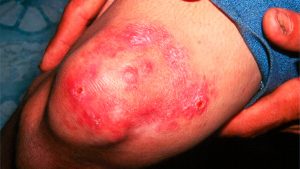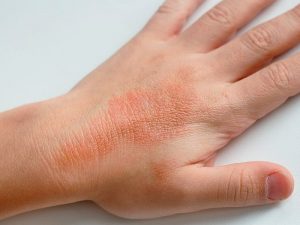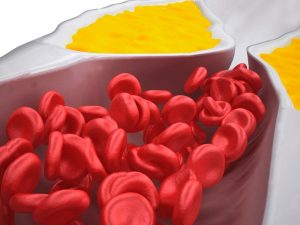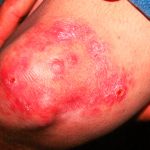Infectious mononucleosis is a contagious disease transmitted through saliva. For this reason, it took the name “kissing disease” since it is more common in adolescents and young adults.
Most adults between 35 and 40 years in the United States have been exposed to the Epstein-Barr virus, which is a widespread virus. When children become infected with the virus, they usually do not experience any significant symptoms; however, uninfected adolescents and young adults who come into contact with the virus may develop infectious mononucleosis.
Epstein-Barr virus can cause mononucleosis in young people. Besides, after symptoms disappear, the virus will remain dormant in the throat (pharynx) and blood cells. The virus reactivates periodically, although usually without symptoms.
Most exposed people to the virus are inhabitants of underdeveloped countries in the first years of their lives. And although most people are likely to get the Epstein-Barr virus at some point in their lives, there are very few cases that develop infectious mononucleosis symptoms. In developed countries such as the United States, first infections occur at a later age of infancy and young adults, when symptoms are more likely to happen.
Infectious Mononucleosis Definition
Mononucleosis, also known as mono or glandular fever is a viral disease characterized by swelling of the lymph glands and chronic fatigue. It is a systemic disease produced 90 per cent of times by Epstein-Barr virus (EBV) that belongs to the same family of human herpesvirus 4 (HHV4). This disease presents symptoms such as a fever or common cold. The virus is found in saliva, mucosa and other bodily fluids.
Although mono is caused mainly by EBV, much less frequently it can be produced by cytomegalovirus and in one per cent of cases by Toxoplasma gondii. Transmission occurs from one person to another through kissing, coughing or sneezing; also, by sharing food utensils or personal items with someone who has mononucleosis.
Most people exposed to EBV do not develop mono. And most adults carry an antibody against EBV in their blood, meaning they have been infected with EBV at some time. Treatment includes rest, pain medication, and in some cases anti-viral medication.
Mononucleosis and Epstein Barr virus
Epstein-Barr virus is one of the most common viruses in humans (family that also includes herpes simplex virus and cytomegalovirus). EBV infects most people at some point in their lives. In this way, people get an adaptive immunity through the development of antibodies against the virus, which usually prevents new infections due to external factors. While it is quite rare, EBV may be able to cause problems in the central nervous system and the heart.
EBV was first reported in 1964 by British scientists M.A. Epstein, Y.M. Barr and B.G. They found virulent particles in tissue cells with recently discovered lymphatic cancer. Epstein-Barr virus infects only two types of cells in the human body, some cells of the salivary glands and white blood cells or leukocytes.
Mononucleosis Symptoms
Typical signs of infectious mononucleosis appear between four and six weeks after EBV infection. Symptoms may occur slowly and not all at the same time. Some of them are:
- Extreme fatigue.
- Fever that rises in the afternoon and night and reaches around 39.5 to 40.5 Celsius degrees.
- Sore throat.
- Headache and pain in the body.
- Swollen lymph nodes in the neck and armpits.
- Inflamed liver or spleen (or both).
- Rash.
- Children or adolescents present pharyngitis with or without tonsillitis.
- Symptoms can last for two to four weeks, but general malaise and fatigue can last for months.
Other symptoms include:
- Mild hepatomegaly and pain from liver percussion.
- Periorbital edema and palatal petechiae.
- Less frequent maculopapular eruptions.
- Rarely, jaundice.
Mononucleosis Rash
Something that differentiates mononucleosis from bacterial pharyngitis is the appearance of red spots on the body after starting antibiotic treatment. Although this is usually the case, the relationship between the disease and sensitivity to antibiotics has not been defined yet. These eruptions may be maculopapular rash and morbilliform rash throughout the body, which in severe cases may turn to erythroderma.
These severe skin manifestations appear in patients who have used antibiotics such as penicillin or another type, and the virus induces these allergic reactions.
Maculopapular rash does not rise above the skin surface. It brings macules – spots on discolored skin; and papules which are small, solid protuberances that cause inflammation of the skin.
Mononucleosis test
- Monospot test (heterophil test)
This quick screening test detects a type of antibody (heterophil) that forms during certain infections. A sample of blood is placed on a microscope slide and mixed with other substances. If heterophil antibodies are present, blood clumps.
This result usually indicates a mono infection. Monospot testing can generally detect antibodies 2 to 9 weeks after infection. This test is not helpful to diagnose mono that started more than six months earlier.
- EBV antibody test
For this test, a blood sample is mixed with a substance that attaches to antibodies against EBV. A series of tests can detect different types of antibodies to help determine whether you were infected recently or sometime in the past.
Infectious Mononucleosis Treatment
Primary goal of treatments is to relieve symptoms; they may include:
- Rest for about a month to allow the body’s immune system to destroy the virus.
- Drink a lot of liquid. It helps to prevent dehydration.
- Relieve pain. Paracetamol relieves fever and sore throat.
- If you have infectious mononucleosis, you should not take ampicillin or amoxicillin.
- Avoid contact sports due to spleen may get bigger and a rupture may happen.
- Corticosteroids can mitigate throat and tonsils inflammation.
Prevention
Measures are very scarce and are mainly related to good hygiene. First of all, it is essential to wash hands frequently. There is no vaccine to protect against infectious mononucleosis so you can help protect yourself by not kissing other people or by not sharing drinks, food or personal items, such as toothbrushes, with people who have the disease.
Additionally, it is essential to avoid contact with containers or utensils (such as forks or knives) that have been used by infected people.










